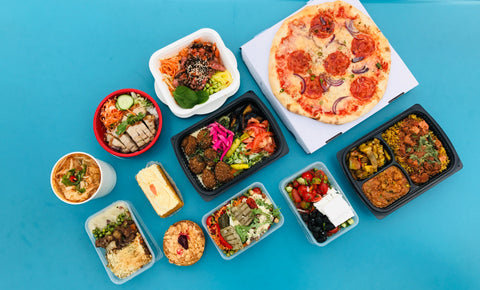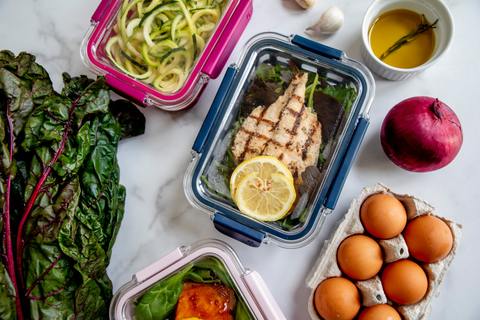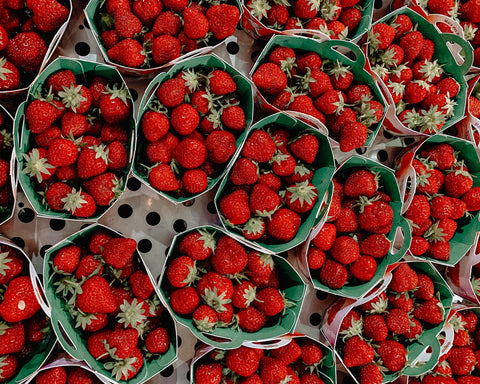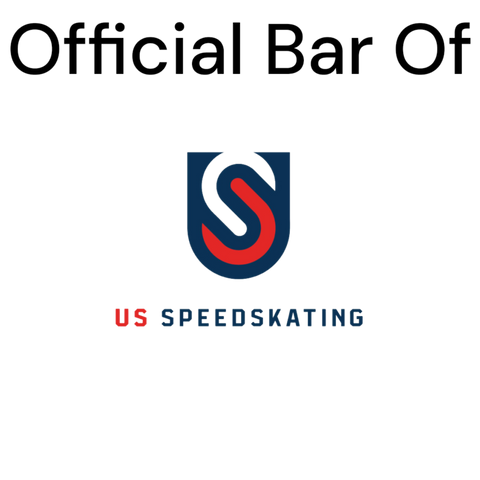
Pick up any packaged food, and you’ll see a Nutrition Label loaded with information based on a serving size. But does that mean you should only stick to that serving?
These questions always come up in healthy eating, so we’ll be answering them in today’s guide. We’ll go over the difference between portion and serving size meanings. And we’ll even share a helpful portion size guide to use if you hate measuring/weighing your food intake.
Not exactly.
A serving size is usually measured in ounces, grams, or specific segments (such as one slice of cheese). Somewhere near the serving size, you can see how many servings each package contains.
A single serving size isn’t a suggested amount you should eat. Rather, it’s used to describe the amount of nutrients that come with one serving, or what’s in one segment of that entire package.
See, food manufacturers outline one serving size to quantify how many calories, macronutrients (such as fat, carbohydrates, and protein), micronutrients, sodium, added sugars, and more you can find in their products.
For example, a small bag of nuts may hold two servings. Each serving may clock 100 calories, five grams of fat, and six grams of protein.
If you eat the whole bag, you’ll be consuming two servings, or 200 calories, 10 grams of fat, and 12 grams of protein. Now, whether you eat one serving or two servings depends entirely on your health and wellness goals.
By understanding:
A serving size will tell you how many calories, macronutrients, micronutrients, etc., are lurking in foods. But it does not show you how much of that item you should eat. That’s why you can’t stop at serving sizes when determining your optimal food intakes. Your next task is to figure out your portion size, or how much of that food you’ll actually eat.
Depending on your age, weight, activity level, metabolism, health conditions, and a few other factors, your portion size could be larger or smaller than what the serving size on that package says.
So you may find that half a serving of nuts is perfect for your quick energy needs, but a full protein bar keeps you sated between meals. And maybe a double serving of vegetables during dinner prevents late-night snacking.
Your portion size is entirely up to you. But knowing how many servings your portion contains helps you track what you’re actually eating (i.e., calories, grams of fat and protein, sodium, etc.).

When you start paying attention to your food intake, you’ll notice that portion and serving sizes can be pretty similar.
For instance, a serving size of rice is typically measured as one-half to one cup. But you might need more or less of this depending on your body.
So once you know what one serving looks like, you’ll be able to estimate your portion size by visual clues alone. Then you’ll know whether your portions contain one serving, two servings, or half servings in between.
Now, measuring and weighing your food will give you the most accurate way to track your portions according to serving sizes.
Unfortunately, most of us don’t have the time or patience for that.
Weighing and measuring food can also be tricky if you’ve ever dealt with eating disorders or you’re more prone to succumbing to them.
That’s why a better approach is to use this handy portion size guide:

Using visual clues like these will help you easily and quickly gauge your food intake without having to track every bite you take.
According to the research summed up in that image, you should use:
- A clenched fist to approximate one cup of cooked rice or pasta
- The palm of your hand to gauge one serving of meat, fish, or poultry
- One handful to measure snacks like nuts and fruit
- Two handfuls to gauge an average serving of vegetables
- Your entire thumb to measure roughly two tablespoons
- The top of your thumb to estimate one teaspoon
While this system won’t show you how many calories you’re consuming, it is a quick way to judge your portion sizes.
So if the serving size of your fave nut butter is two tablespoons, you can use your thumb to estimate this amount. If your portion is more or less than this serving size, you’ll need to do some math to figure out what it contains as far as calories or sugar, for example.
Again, your portions can vary based on the factors mentioned earlier, but the serving size will remain the same. These helpful visuals make an excellent place to start estimating both.
Once you become more familiar with portion and serving sizes, you can determine the best amounts for your body.
To do this, track your food intake for a minimum of seven days (and for up to 30 days, ideally). Record the amount of everything you eat and write down how you feel afterward to get an average of your daily/weekly needs.
For example, you might start out with one full portion of carbohydrates, but find that it’s more than your body needs (or may not be enough). The only way to know for sure is to try it out, see and track how you feel, and make adjustments from there.
Keep checking your food log for fluctuations in your mood, energy levels, weight, muscle mass, and more. Then you’ll have a better understanding of your personal dietary needs.
If you’re like most people, you’re probably surprised to learn that the serving sizes listed on Nutrition Labels aren’t actually what you need to stick to.
As we discussed, a serving size only tells you how many calories, macronutrients, micronutrients, and more you’ll find in a segment of the entire product.
Your portion size is how much of that serving (or how many servings) you need to eat to reach your health and wellness goals. Finding your ideal portion sizes will likely take some trial and error. But once you learn the sweet spot, identifying healthy portion sizes will become second nature. And you’ll be one giant step closer to reaching your goals.
Author: Devan Ciccarelli
Email: devan@behappynothangry.com
Instagram/Facebook Group: @behappynothangry/Be Happy Not Hangry
Website: www.behappynothangry.com




